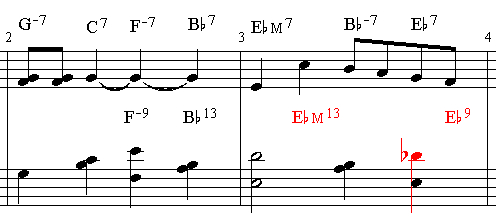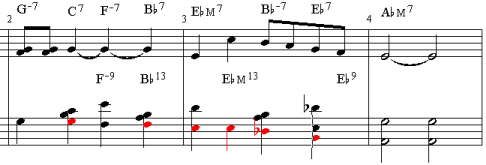In part 3 we took a look at adding the root note and seventh intervals to the Christmas song and developed a bass line for the added chords to create movement within measures two and three.
Continue to remember that our key signature is Eb, so that B, E and A notes are always flat unless we identify it otherwise.
Of course, there were several choices you could make as to which note or 7th you want to add at each of these locations and we took a closer look at my choices. The bass line grew to a pattern of spread and close notes.
We also looked at the how by adding the seventh intervals and looking at the notes we have compound or extended chords for jazz arrangements where we started by identifying the 9th and 13th intervals. I asked you to take a look at measure three and come up with a similar type of call outs for the chords. Here is what I have.

As you can see in the score above I've called out the EbM13 and the Eb9. Notice the highlighted Db, with the Eb7 call out here I had originally had a D natural which was incorrect for the Eb7 chord which was not major. Sometimes it's very easy to overlook this type of addition to your chords. The F in the treble clef is a 9th (7+2) in the Eb chord.
Next I said we would be smoothing out our base line voice leading so that I didn't have a such a back and forth jump of bass notes. My objective at this point is to add chord notes to see if I can make the bass bottom note walk down or step toward the Ab in measure 4.
Here is my first attempt at making this happen.

I've highlighted the notes I've added and we can walk through them beat by beat.
Take note that the measure numbers are at the top left start of each measure.
Measure 2 beat 2, I added a G note in the bass this is the fifth of a C chord and fits nicely with the flow staying on G from the G-7 in the previous beat. It leads to the F in the next beat with a whole step down in the Eb scale.
In beat 4 I doubled up on the F again using the same logic as before with the F as the fifth of the Bb7 chord. It leads down again to the Eb in measure 3, another whole step in the scale.
Now you might have noticed that I changed the first beat in measure 3 from a half note to a quarter note and then added a second Eb quarter note for beat 2. I did this to give me more options as we arrange the bass clef chord notes. I may choose to tie it together or I may decide that I want to add more excitement to the chords later on. For now I've given myself some options. I haven't added a seventh or other notes yet as I'm not sure where I want to go with it just yet.
Continuing at beat 3 measure 3 you can see I've added the minor 3rd, Db to the Bb-7 chord. This was a another whole step down from the Eb. You can take note that we have modified the Eb Scale harmonic system where the D is part of the scale and now we are using the Db.
As you can see we have smoothed the bass line a fair amount getting to the third beat of measure 3. This last beat in measure 3 I added the fifth interval of Eb7 chord as the Bb. This was a minor 3rd drop, but still fairly close in the bass line. It also leads nicely as a whole step to the Ab in measure 4.
So today we can another step in arranging our song using the music theory principles of following the Eb scale with a modification to the seventh note in measure 3. We used fifth and minor 3rds of chords to smooth out the base line giving us various inversions of the chords. And we learned a little about voice leading the bass line.
I've tried to keep it simple in what was applied and related it in passing to the music theory so that you can get a flavor of applied principles.
In the next installment I want to start looking at filling in the chords with more notes and arranging some of the notes to fit into the treble clef. As you look at measure 3 beat 4 you can see that the chord in the bass clef has a very large stretch for trying to play it. You might want to take a shot at rearrange some notes yourself.
Until next time, stay tuned!